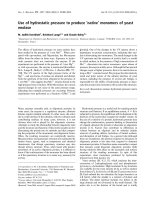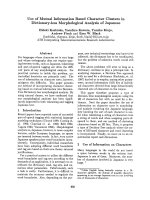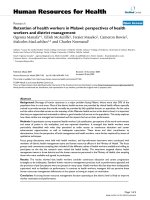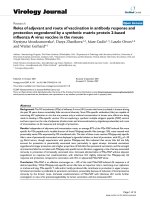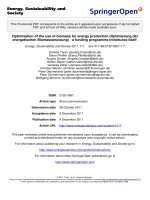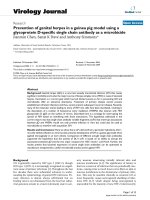Báo cáo sinh học: " Use of sparse matrix in animal breeding" potx
Bạn đang xem bản rút gọn của tài liệu. Xem và tải ngay bản đầy đủ của tài liệu tại đây (397.22 KB, 10 trang )
Original
article
Use
of
sparse
matrix
absorption
in
animal
breeding
B.
Tier
S.P.
Smith
University
of New
England,
Anirreal
Genetics
and
Breeding
Unit,
Ar!nidale,
NSW
2351,
Australia
(received
1
March
1988;
accepted
1
June
1989)
Summary -
Although
the
capacity
of
modern
computers
is
increasing
dramatically
so
too
are
the
complexity
of
models
that
animal
breeders
employ,
with
the
result
that
we
still
find
computers
limiting.
This
paper
demonstrates
the
employment
of linked
lists
for
sparse
matrix
manipulations
and
their
use
in
a
number
of
relevant
applications.
animal
breeding -
prediction
of
genetic
merits -
numerical
methods -
sparse
matrix
Résumé -
Utilisation
en
génétique
animale
de
l’absorption
dans
des
matrices
creuses.
Malgré
l’accroissement
de
capacité
des
ordinateurs,
la
complexité
également
croissante
des
modèles
employés
en
génétique
animale
nécessite
le
raffinement
des
méthodes
numériques.
Cet
article
explique
l’utilisation
de
listes
liées
pour
manipuler
de
très
grandes
matri-
ces
creuses,
et
illustre
leur
usage
dans
différents
types
d’application
dans
le
cadre
de
l’évaluation
des
reproducteurs:
absorption
d’effets
fixes,
inversion
de
matrices,
estimations
de
composantes
de
la
variance
par
le
maximum
de
vraisemblance.
génétique
animale -
évaluation
des
reproducteurs -
analyse
numérique -
matrices
creuses
INTRODUCTION
As
the
capacity
of
modern
computers
increases
so
does
the
quantity
of
data
and
the
complexity
of
models
that
animal
geneticists
wish
to
use
in
their
analyses.
In
the
early
years
of
computing
when
main
memory
was
a
major
limitation,
a
variety
of
techniques
were
developed
to
utilise
efficiently
that
memory
which
was
available
(Bunch
and
Rose,
1976).
This
paper
illustrates
the
use
of
one
of
these
techniques -
linked
lists -
to
store
sparse
matrices
and
eliminate
(absorb)
equations.
Examples
are
given
of
how
this
technique
can
be
useful.
TYPICAL
MODELS
Linear
models
that
are
commonly
used
by
animal
geneticists
have
qualities
that
lend
themselves
to
efficient
methods
of
storage.
Consider
the
model:
where
y
is
a
vector
of
observations;
X
and
Z
are
incidence
matrices;
b
is
a
vector
of
fixed
effects;
u
is
a
vector
of
random
animal
(or
sire)
effects;
and
e
is
a
vector
of
random
residuals.
Animals
(sires)
are
related.
The
mixed
model
equations
(Henderson,
1974)
are
where
G
is
the
covariance
matrix
of
u,
and
R
is
a
covariance
matrix
of
residuals.
For
a
univariate
analysis
G
=
7A
for
some,
where
A
is
the
numerator
relationship
matrix.
be
the
mixed model
array.
Because
Q
is
symmetric
it
is
only
necessary
to
store
the
upper
(or
lower)
triangle.
This
means
that
more
equations
can
be
stored
in
the
memory.
When
an
animal
model
(or
reduced
animal
model)
is
employed,
then
Q
is
very
sparse.
LINKED
LISTS
A
linked
list
consists
of
a
list
of
elements
linked
together
by
pointers
to
their
physical
locations.
The
physical
location
of
the
first
element
in
the
row
is
stored
and
every
element
has
associated
with
it
a
pointer
to
the
location
in
the
memory
of
the
next
element
in
the
sequence.
The
pointer
associated
with
the
last
element
in
the
list
is
zero.
Knuth
(1968)
provided
a
detailed
explanation
of
linked
lists.
When
using
FORTRAN
3
vectors
are
required
to
store
a
matrix
in
this
way -
one
for
the
element
(a
u
),
one
for
the
column
(J)
and
one
for
the
pointer
to
the
next
element.
A
scalar
(NUSED)
is
used
to
point
to
the
last
occupied
location
in
these
vectors.
As
the
list
is
being
built,
new
elements
are
stored
in
the
next
available
location
in
these
vectors
but
the
order
of
the
row
is
maintained
by
adjusting
the
pointers
(illustrated
in
Table
I).
Because
matrices
such
as
Q
and
G-
1
are
sparse,
they
lend
themselves
to
this
form
of
storage.
To
store
a
matrix
of
order
N
the
first
N
elements
in
the
storage
vectors
are
reserved
for
the
first
element
in
each
row.
Each
row
forms
its
own
linked
list.
Because
they
are
symmetrical,
it
is
possible
to
store
the
upper
(or
lower)
triangle
only -
thus
the
first
(last)
element
in
any
row
is
the
diagonal.
Consider
the
simple
linear
model
where
A
and
B
are
systematic
effects
with
2
classes
each.
Assign
the
effects
A1,
A2,
B1
and
B2
to
equations
(1)
to
(4)
respectively
and
the
right-hand
side
to
equation
(5).
Reserve
the
first
5
elements
in
the
vectors
for
the
first
(diagonal)
element
in
each
row.
Store
the
address
of
the
last
occupied
location
(5)
in
the
scalar
NUSED.
The
mechanics
of
using
a
linked
list
are
illustrated
by
3
records
shown
in
Table
II.
Each
record
generates
6
contributions
to
the
upper
triangle.
Each
of
these
is
either
an
addition
to
an
existing
element
or
a
new
element.
In
both
cases,
it
is
necessary
to
follow
the
sequence
of
pointers
along
the
particular
row
until
either
the
element
is
found,
or
an
element
which
lies
to
the
right
of
the
current
contribution
is
found,
or
the
end
of
the
row
is
found.
If
the
element
is
found
in
the
list
then
the
current
contribution
is
added
to
it.
If
the
element
is
new
then
it
is
stored
in
the
next
available
location
and
the
pointers
(in
the
row
and
to
the
last
occupied
location)
are
adjusted
accordingly.
A
simple
algorithm
to
do
this
is
shown
in
the
Appendix.
The
matrix
Q
derived
from
the
3
records
in
Table
II
is
Table
III
illustrates
the
status
of
the
linked
list
after
each
record
has
been
processed.
If
iteration
(e.g.
Gauss-Seidel)
is
to
be
the
only
manipulation
involving
Q,
then
the
vectors
containing
the
coefficients
and
column
identities
can
be
sorted
after
building
Q
and
the
pointers
associated
with
the
first
N
elements
can
be
used
to
store
the
number
of
elements
in
each
row.
However,
to
implement
absorption,
the
pointer
vector
must
be
maintained.
ABSORPTION
OF
EQUATIONS
Absorption
or
gaussian
elimination
is
described
in
Smith
and
Graser
(1986).
If
the
sparsity
of
the
matrix
is
to
be
preserved,
as
is
desirable
for
a
linked
list
to
be
useful,
then
it
is
important
to
choose
pivots
so
that
new
elements
do
not
proliferate.
Gill
and
Murray
(1974)
suggest
choosing
rows
with
the
least
number
of
off-diagonal
elements
first.
As
each
row
is
absorbed,
the
space
it
occupied
is
released
and
can
be
made
available
to
new
elements
that
are
created
in
other
rows.
Before
absorbing
any
equations,
it
is
useful
to
link
the
unoccupied
space
in
the
vectors
into
a
separate
linked
list.
As
space
is
released,
it
can
be
added
to
the
list
of
free
space
for
reuse.
Because
the
elements
in
the
row
are
already
connected
by
pointers,
the
complete
row
can
be
placed
at
the
start
of
the
list
of
free
space
by
modifying
the
pointers
at
the
end
of
the
row
and
at
the
start
of
the
free
space.
If
backward
substitution
is
to
be
implemented
then
the
row
should
be
written
as
an
exterior
file.
After
absorbing
the
first
row
of
Q
and
its
linked
list
representation
is
shown
in
Table
IV.
There
is
no
need
to
zero
the
column
and
coefficient
vectors
from
the
row
being
absorbed;
when
this
space
is
reused
they
will
be
assigned
new
values.
During
elimination
of
each
row
of
Q,
it
is
possible
to
design
the
algorithm
so
that
subsequent
rows
and
elements
within
rows
are
modified
sequentially;
redundant
searching
through
Q
can
and
should
be
avoided.
If
the
selected
pivot
is
zero,
then
the
row
can
be
regarded
as
having
been
preabsorbed.
An
algorithm
to
absorb
equations
in
this
manner
is
shown
in
the
Appendix.
For
large
problems,
it
is
possible
and
desirable
to
divide
Q
into
2
parts:
an
exterior
file
and
a
linked
list.
Absorption
of
a
row
entails:
reading
the
row
from
the
exterior
file;
merging
the
input
with
the
linked
list;
and
absorbing
the
row
in
the
linked
list.
When
the
linked
list
is
full,
it
can
be
merged
with
the
exterior
file
so as
to
create
a
new
exterior
file.
This
clears
the
vectors
for
a
new
iteration.
APPLICATIONS
All
the
following
examples
have
the
form
of
manipulating
a
matrix
by
absorbing
U
row
by
row
to
give
Row
by row
absorption
is
equivalent
to
repeated
application
of
the
formula
for
W*,
where
U
is
a
scalar
(the
pivot)
and
T
is
a
column
vector.
1)
Sparse
matrix
inversion
For
example,
find
E-
1
given
the
positive
definite
and
symmetric
matrix
of
E.
Set
U
=
Enxn
T
=
Inxn
W
=
Onxn
then
W* =
-E-1
Sometimes
only
the
diagonal
of
E-
1
may
be
required,
in
which
case
the
calculation
and
storage
of
off-diagonal
elements
of
E-
1
can
be
neglected.
2)
Estimation
of
(co)variance
components
by
maximum
likelihood
(ML)
or
restricted
maximum
likelihood
(REML)
Many
of
the
arrays
in
this
section
can
be
found
in
Searle
(1979).
a)
Evaluate
in
ML
b)
Evaluate
in
REML
c)
Evaluate
Z’PZ
in
REML :
method
1
d)
Evaluate
Z’PZ
in
REML :
method
2
e)
Evaluate
the
log-likelihood
(L)
for
REML
using
the
derivative
free search
of
Graser
et
al.
(1987).
To
evaluate
L
we
note
that
where
I UI
is
the
determinant
of
one
of
the
largest
non-singular
submatrices
of
U;
and
I UI
is
evaluated
by
the
product
of
the
non-zero
pivots.
To
implement
a
derivative-free
search
sometimes
we
need
rank(X)
which
is
the
number
of
non-zero
pivots
minus
the
order
of
G-
1.
3)
Calculating
the
exact
A-’
for
sub-populations
When
a
sire
model
is
used
it
is
possible
to
build
A-’
for
the
full
pedigree
of
the
sires
and
then
absorb
all
female
relatives.
Some
sires
may
be
absorbed
as
well
if
they
are
not
part
of
the
subpopulation.
Partition
A-’
into
2
parts:
animals
to
be
absorbed
in
U,
and
animals
that
are
to
remain
in
W.
The
W*
is
the
exact
inverse
relationship
matrix
for
the
remaining
selected
animals.
Experience
has
shown
that
absorption
seems
to
create
many
elements
that
are
essentially
zero.
Linked-list
absorption
works
well
when
these
zero
elements
are
released
from
storage,
particularly
from
a
row
before
it
is
absorbed.
4)
Conducting
secondary
absorptions
Sometimes
it
is
necessary
to
absorb
2
groups
of factors
out
of the
model.
The
model
used
by
Smith
(1987)
included
2765
effects
representing
contemporary
groups,
2611
1
fixed
sire
effects
and
539
random
sires.
Rows
representing
contemporary
groups
were
absorbed
as
the
data
were
read.
Then
rows
representing
fixed
sires
were
absorbed
in
a
reasonable
time
using
sparse
matrix
techniques.
The
absorption
of
the
fixed-sire
effects
would
have
been
impossible
using
matrix
inversion.
The
order
used
for
the
secondary
absorption
was
determined
by
the
size
of
the
diagonals
after
the
primary
absorption.
Rows
with
smaller
diagonals
were
absorbed
first.
This
order
is
opposite
to
the
usual
practice,
however,
it
minimizes
the
creation
of
non-zero
elements
and
hence
preserves
the
efficient
use
of
memory.
Use
of
the
traditional
approach
would
have
been
as
impossible
as
matrix
inversion.
5)
Partial
absorption
prior
to
iteration
Sometimes
it
may
be
advisable
to
absorb
some
equations
prior
to
iteration,
such
as
is
implicitly
done
using
the
reduced
animal
model
(Quaas
and
Pollak,
1980).
CONCLUSION
Some
of
the
applications
we
have
described
may
not
be
practical.
For
example,
evaluating
V-
1,
P
and
Z’PZ
may
be
beyond
current
computing
capabilities
even
with
a
linked
list.
However,
some
of
the
applications
(e.g.,
evaluating
L,
constructing
A-
1
for
sub-populations,
and
secondary
absorptions)
are
realistic
and
have been
tested
on
real
data
structures.
Without
linked
lists
these
applications
may
not
be
feasible.
A
common
misconception
is
that
evaluating
Q-
1
is
about
as
difficult
as
absorbing
all
rows
of
Q.
For
non-sparse
matrices,
inversion
requires
3
times
the
work
of
absorption.
For
sparse
matrices
the
comparison
is
typically
much
more
extreme.
Inversion
can
be
prohibitive
even
with
a
linked
list,
while
absorption
of
the
same
matrix
may
be
a
relatively
simple
operation.
REFERENCES
Bunch
J.R.
&
Rose
D.J.
(ed.)
(1976)
Sparse
Matrix
Computations.
Academic
Press,
New
York
Gill
P.E.
&
Murray
W.
(1974)
Methods
for
larger
scale
linearly
constrained
problems.
In:
Numericad
Methods
for
Constrained
Optimisation.
(Gill
P.E.
&
Murray
W.
(ed.),
Academic
Press,
London,
pp.
93-147
Graser
H U.,
Smith
S.P.
&
Tier
B.
(1987)
A
derivative
free
approach
for
estimating
variance
components
in
animal
models
by
REML.
J.
Anim.
Sci.
64,
1362-1370
Henderson
C.R.
(1974)
Sire
evaluation
and
genetic
trends.
In:
Proceedings
of
the
Animal
Breeding
and
Genetics
Symposium,
Blacksburg,
July
29,
1972,
Am.
Soc.
Anim.
Sci.
and
Am.
Dairy
Sci.
Assoc.,
Champaign,
IL.,
p.
10
Knuth
D.E.
(1968)
The
Art
of
Computer
Programming,
vol.
1.
Fundamentad
Algorithms,
Addison
Wesley,
Reading,
MA
Quaas
R.L.
&
Pollak
E.J.
(1980)
Mixed
model
methodology
for
farm
and
ranch
beef
cattle
testing
programs.
J.
Anim.
Sci.
51,
1277-1287
.
Searle
S.R.
(1979)
Notes
on
variance
components
estimation:
a
detailed
account
of
maximum
likelihood
and
kindred
methodology.
Paper
BU 673M.
Biometrics
Unit,
Cornell
University,
Ithaca,
NY
Smith
S.P.
(1987)
Genetic
parameters
for
type
in
Australian
Holstein-Friesian
dairy
cattle.
In:
Proceedings
of
the
Sixth
Conference,
Australian
Assoc.
of
AniTrc.
Breeding
Genet.,
Perth,
Australia,
February
9-11,
1987,
Anim.
Genet.
Breeding
Unit,
University
New
England,
Armidale,
pp;
55-58
Smith
S.P.
&
Graser
H U.
(1986)
Estimating
variance
components
in
a
class
of
mixed
models
by
restricted
maximum
likelihood.
J.
Dairy
Sci.
69,
1156-1165
APPENDIX
Subroutines
LINKAIJ,
LINKFREE
and
ABSROW
The
following
storage
is
required
for
these subroutines:
ELEMENT(LENGTH)
is
a
vector
of
elements.
POINTER(LENGTH)
is
a
vector
holding
pointers
to
the
next
element
in
the
row.
JAY(LENGTH)
is
a
vector
holding
the
column
(J)
of
the
element.
NUSED
is
a
pointer
to
the
last
occupied
location
in
these
vectors.
ITHIS
and
NEXT
are
pointed
to
this
and
the
next
element
respectively.
Subroutine
LINKAIJ
stores
the
contribution
to
the
element
a I j
which
are
passed
as
parameters.
Subroutine
LINKFREE
links
up
the
free
space
in
POINTER
and
initialises
IHEAP
before
ABSROW
is
called.
IHEAP
points
to
the
next
available
location
in
the
vectors.
Subroutine
ABSROW
absorbs
the
i
th
row.
The
it!’
row
is
transferred
to
two
work
vectors
(WORK
which
contains
the
elements
and
JWORK
which
contains
the
columns).
Space
released
by
this
transfer
is
placed
in
the
available
heap
and
then
the
row
is
absorbed.
OPZERO
is
the
operational
zero
(if
the
absolute
value
of
the
element
is
less
than
OPZERO
it
is
treated
as
being
zero).
